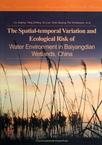白洋淀流域生态风险评价与生命周期管理
2012-11
中国环境科学出版社
刘静玲
137
224000
《白洋淀流域生态风险评价与生命周期管理(英文版)》由刘静玲等人著,主要内容:Baiyangdian Wetlands known as
famous "Pearl of North China" and as Beijing's "back garden" is
decorated by beautiful reed marshes, lotus, wild ducks, and carp.
In the contrast, its reputation is hard to live from the
perspective of environmental issues. It has been intertwined with
ecological and environmental accidents such as killed fish
accidents and dried precipitate. The issues on ecology and
environment of Baiyangdian Wetlands have attracted public concerns
from worldwide experts, government and mass media. The research
focused on Baiyangdian Wetlands which have been reported.
Chapter 1 Introduction
1.1 Characteristics of Baiyangdian Watehed
1.2 Evolvement of Water Environment of BYD
1.2.1 Water level and water quantity
1.2.2 Water quality
1.2.3 Water ecosystem
Chapter 2 Spatial-temporal Characteristics of Water Quality
and Its Impact Facto in Baiyangdian Watehed
2.1 Spatial-temporal characteristics of surface water
quality in BYD watehed
2.1.1 Temporal variation
2.1.2 Spatial distribution
2.2 Analysis of impact facto
2.2.1 Natural facto
2.2.2 Social facto
2.3 Summary and recommendation
Chapter 3 Spatial and Temporal Changes of Landscape Patches, Land
Use in Baiyangdian Wetlands
3.1 Spatial and temporal changes of landscape patches
3.l.1 Landscape changes in BYD
3.1.2 Patches spatial-temporal variation
3.1.3 Spatial-temporal variation of dominate patches
3.2 Land use changes and its effects on water quality in BYD
3.2.1 Characteristics of land use in BYD during the last 20
yea
3.2.2 Changes of land use in BYD during last 20 yea
3.2.3 Correlative analysis between land use change and
water quality
3.3 Summary and recommendation
Chapter 4 Pollution Characteristics and Ecological Risk of
Baiyangdian Wetlands
4.1 Characteristics and Risk Analysis of PAHs in BYD
4.1.1 PAHs concentratio and composition profiles
4.1.2 Ecological risk assessment of PAHs
4.2 Characteristics and Risk Analysis of heavy metals in BYD
4.2.1 Concentration and spatial distribution of heavy
metals
4.2.2 Ecological risk of heavy metals
4.3 Emergingt pollutants and ecological risk
4.4 Summary and recommendation
Chapter 5 Analysis and Comparison of Water Resources
Management and Policy in Baiyangdian Watehed
5.1 Study on common resource management policies by
comparative analysis
5.1.1 Theoretical background for the compariso
5.1.2 The two study areas: BYD (China) and Mariager fjord
(Denmark)
5.1.3 The development of environmental regulation and its
impact
on the two water bodies ;
5.1.4 Comparison of environmental capacity in China and
Denmark
5.2 Participation analysis and assessment of BYD
5.2.1 Sample determination
5.2.2 Government administration
5.2.3 Residents in the watehed
5.2.4 Cognitive and acceptance of residents....
5.3 Summary and recommendation
Chapter 6 Conclusio and Future Work
6.1 Conclusio
6.2 Future work
References
Index of Figures
Index of Tables
5.1.3.2 Environmental regulation and its impact on Mariager flord Environmental protection in Denmark started out with some specific laws on watercourses, in 1880 and nature conservation in 1916. These laws primarily reflected the fact that the impacts from industrialization and urbanisation had started to influence the natural environment in Denmark. After the World War n, not only industry but also agriculture began to develop rapidly. Like most other countries Denmark experienced severe environmental problems in the 1960s leading to the formation of environmental NGOs, increased focus on ecological sciences and increased political acceptance of new legislation. This was heralded by the UN Stockholm conference in 1972 which inspired most countries to adopt environmental legislation. This was also the case for Denmark. In 1974 a new law of environmental protection was launched together with the establishment of a new planning system that required counties as well as municipalities to make regional plans and municipal plans respectively. The new law of environmental protection included two strong regulatory instruments. First of all, the law included old provisions for giving waste-water licences to industries, as well as requirements for municipal waste-water treatment plants. The issuing of licences should now be seen in connection with the goals established in the regional plans especially related to water quality planning. Another feature of the law of environmental protection was that now larger, newly established industries should obtain an environmental permit before starting new production or expanding existing facilities. The tie between the law on environmental protection and on regional planning was already very strong from the outset in the early 1980s. In the first regional plan of 1981 no goals were formulated for the quality of Mariager fjord but in the regional plan of 1985 there was now formulated a very brief goal stating that '...these areas should function as habitats for animal and plant life, and should be able to be used for fishery bathing and other recreational puiposes'.In the first water quality plan for Nordjyllands County from 1986 a goalwas set that aimed at a Secchi depth of greater than 3 m and a concentration of nitrogen and phosphorus as presented in Table 5.6. At this point it was already clear that the condition of the fjord was not acceptable. As the consequence of the goals formulated in the regional plan the municipalities around the fjord were obliged to improve their waste-water treatment facilities. The separate water quality plan of 1986 was integrated into the regional plan of 1989 adopting the same measures as presented in Table 5.6, and the only difference was that it was now underlined that not only should 'it function as habitats for animal and plant life' but for a versatile animal and plant life'. In the regional plan of 1993 the goals were the same once more, but now the conditions had changed. While nitrogen was regulated in the mid-1980s as a result of the action plan for the aquatic environment, now new demands were put on the discharge of phosphorus. While the action plan for the aquatic environment generally set a threshold on 1 mg/L of waste water it was within the discretionary power of the counties to set lower threshold values. In the regional plan of 1993, Hobro waste-water treatment plant accordingly had a threshold value of 0.4 mg/L(P) while the remaining waste water treatment plants could continue with 1.0 mg/L(P). ……
